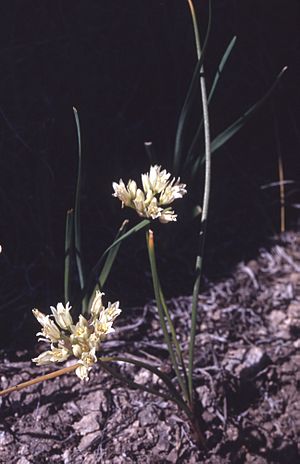Prairie onion facts for kids
Quick facts for kids Prairie onion |
|
|---|---|
 |
|
| Scientific classification | |
| Synonyms | |
|
Synonymy
Allium angulosum Pursh 1813, illegitimate homonym not L. 1753
Allium aridum Rydb. Allium geyeri var. textile (A. Nelson & J.F. Macbr.) B. Boivin Allium reticulatum Fraser ex G. Don 1827, illegitimate homonym, not J. Presl & C. Presl 1817 Allium reticulatum var. playanum M.E. Jones Maligia laxa Raf. |
The prairie onion (scientific name: Allium textile) is a common type of wild onion. You can find it growing in the central parts of North America. It's also sometimes called the textile onion.
Contents
What Does the Prairie Onion Look Like?
The prairie onion grows from egg-shaped bulbs. These bulbs can be up to 2.5 centimeters (about 1 inch) long. Unlike some plants, it does not have rhizomes, which are underground stems.
The plant has a tall, round stem called a scape. This scape can grow up to 40 centimeters (about 16 inches) tall.
Flowers and Pollen
The flowers of the prairie onion are shaped like bells or small pots. Each flower is about 6 millimeters across. Their petals, called tepals, are usually white or pink. They often have reddish-brown lines down the middle. The pollen and the parts that hold it, called anthers, are bright yellow.
Where Does the Prairie Onion Grow?
The prairie onion is native to a large area in North America. It grows across the Great Plains states in the United States. This includes places from Oklahoma up to Montana and Minnesota.
It also lives in the Rocky Mountains and Great Basin regions. You can find it from northern New Mexico all the way to Washington. In Canada, it grows in the provinces of Alberta, Saskatchewan, and Manitoba. There has also been one report of it growing in Indiana.
Preferred Habitat
This wild onion likes dry, sunny places. It grows at different heights, from about 300 meters (around 1,000 feet) to 2,400 meters (nearly 8,000 feet) above sea level.


